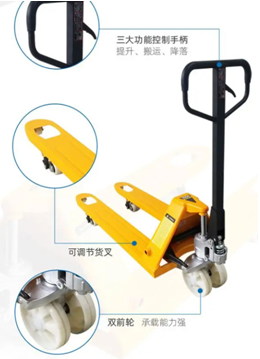News Details
Structure of Chinese manual hydraulic carrier

Manual hydraulic carrier? This equipment, which is called "cattle" and "small tank handling", can play a significant role in the field of loading and unloading!
1 Structure of manual hydraulic carrier
The manual hydraulic carrier is mainly composed of four parts: handle, oil cylinder, fork and wheel.
The handle acts as a manual pressure to control the lifting of the hydraulic oil cylinder; The oil cylinder is composed of grinding pipe, sealing ring, integrated valve core, etc. The lifting is driven by hydraulic pressure, greatly enhancing the safety; Forks are generally made of steel plates; The wheels are made of nylon. Compared with ordinary PU wheels, they have better wear resistance and are most common in use.
2 Working principle of manual hydraulic carrier
The manual hydraulic carrier uses the hydraulic transmission principle, takes the oil as the working medium, transfers movement through the change of the sealing volume, and transfers power through the pressure inside the oil to achieve the effect of lifting heavy objects, and can control the lifting and lowering of the fork.
It has the functions of consigning and lifting goods. The linkage between the chassis and wheels and the hydraulic device are mainly used to facilitate the takeoff and landing of goods. The specific work process is as follows:
First, insert the fork into the pallet under the goods, lift the chassis, move the goods through the manual control hydraulic system, and after arriving at the destination, also use the hydraulic pressure to lower the chassis, so that the goods will land with it, and then pull out the carrier, saving the complex process of manual handling.
3 Daily maintenance of manual hydraulic carrier
The manual hydraulic carrier is called "Diniu" because of its simple shape and powerful functions. However, this simple equipment often has some problems, such as slow rise, or simply cannot rise.
The first reaction of many people may be - is the car broken? In fact, this is not the case. In most cases, there is air in the oil pump of the hydraulic vehicle. At this time, simply exhaust the air. If the air factor is eliminated, it is advisable to check whether the screws at the adjustable hydraulic valve are fastened. The tightness of the screws can change the speed of rising and falling.
Here is a brief introduction to the daily maintenance of the manual hydraulic carrier.
▲ Exhaust
Due to transportation or inversion of the pump body, air is likely to enter the hydraulic pump, which will result in no rise of the cargo pressure during the lifting process. You can pull the handle to the falling position and move it up and down repeatedly to exhaust air.
▲ Lubrication
It is necessary to add lubricating oil to all parts regularly to reduce wear, seal and prevent leakage.
04 Precautions for manual hydraulic carrier
▲ When pulling the carrier, it is usually necessary to pull the finger control handle to the middle position, which is conducive to reducing the rebound force of the small piston on the handle when moving the handle, and also plays a role in protecting the hydraulic seals and piston components and extending the service life of the carrier
▲ It is strictly forbidden to use the vehicle by people who are unfamiliar with the vehicle and have not received training
▲ Manned operation is strictly prohibited
▲ It is strictly prohibited to use it in places with slope to avoid rollover
▲ During the handling of goods, others should keep away from forks by 600mm
▲ Pay attention to the center of gravity of goods to avoid eccentric load and inclination,
▲ It is forbidden to lift goods with a single fork to avoid rollover or fork damage
▲ Overload is strictly prohibited
▲ When lowering the fork, it is strictly forbidden to extend hands and feet under the fork
▲ When the manual hydraulic truck is not in use, it is recommended that it be unloaded and the fork be lowered to the lowest position.

